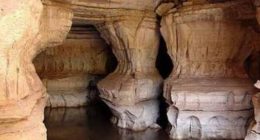The legacy of the Queen of Sheba lies just below the shifting sands, and churches hewn out of sheer rock attract wide-eyed tourists. The African nation’s historic route begins in the ancient city of Axum, which dates to about 100 B.C. This capital city was the first place in Ethiopia to adopt a new religion — Christianity. According to the Old Testament, The Queen of Sheba was born in Axum, but travelled to Israel to meet King Solomon.
Menelik
They had a son named Menelik, who later became the first emperor of Ethiopia. Menelik brought the original Arc of the Covenant back to Ethiopia from Israel. Today, the Arc, which once housed the Ten Commandments, remains well hidden in Axum. It is guarded by a select group of monks, whose sole commitment is to protect the sacred vessel. Axum is also known for its massive, towering sculptures that are more than two thousand years old. Their significance is still under investigation by archaeologists.
2,000 Years
365 kilometres northeast of Gondar lies the town of Axum, Ethiopia’s oldest city. Axum dates back some 2,000 years to when it was the hub of the Axumite Empire. The Queen of Sheba made it her capital 1000 years before Christ. The Ethiopian Orthodox Church was founded here in the fourth century and Axum remains the holiest city of the Ethiopian Orthodox Church.
All that remains now of Axum’s past glories are the huge granite stelae (pillars), some fallen and some still perpendicular. Made of single blocks of granite, the tallest stood over 33 metres high – the largest monolith in the world. The biggest now standing is 23 metres high.
Obelisk
All three section of the 1,700-year old Axum obelisk has arrived back in Ethiopia, 68 years after it was looted by Italian fascists. Many Ethiopians see the obelisk as an important national symbol – its return has been subject to great national anticipation and excitement. Seized back in 1937 by Italian troops, it was taken to Rome where it remained, despite a 1947 UN agreement to return it to Ethiopia. It was eventually dismantled into three pieces in 2004 in preparation for its journey home, an operation which is costing Italy an estimated 6 million euros (£4.1 million). The monument is due to be re-erected after the rainy season.
Getting There And Away
If travelling into Eritrea the Rama border post, which is about 1 hour’s drive from Axum, opens at 0900. The 120 kilometre journey between Axum and Adigrat takes 4 hours by bus. There are frequent minibuses between Axum and Adwa. Close to Adigrat the road climbs up to over 3,000 metres, offering a view of the highest peak, Alegua, at 3, 291 metres, and overlooks the Hista River gorge offering spectacular views.
Route from Addis is via Bahar Dar and Gondar and the whole journey is 1,100 kilometres. Good sealed road to Adigrat. Access is difficult June-September when the rains are heavy. Allow at least 4 days for the journey there, with stops in Debre Markos, Bahar Dar and Gondar. There are regular buses running along this route.
The 16th century Church of St Mary of Zion is the holiest Christian sanctuary in Ethiopia, and Ethiopians believe that the church houses the Ark of the Covenant, containing the tables on which Moses wrote the Ten Commandments. Menelik is reputed to have brought it to Axum, along with 12,000 Jewish children. The Chapel is constantly guarded by monks, and not even the President has sufficient authority to enter.
The Bazen, Kaleb, Ghenet and Africa hotels all have a bar and restaurant. There are also plenty of basic 1 star cafes in town. The Mini Pastry next door to the Kaleb Hotel has a courtyard.
The bus stand in Axum is right in the centre next to the Big Tree. There are 2 buses daily to Asmara, one departs at 0800, the journey is 170 kilometres. Journey takes 12 hours. Ensure you have a valid Eritrea Visa.
The entrance ticket to the sights of Axum allows only one entry to each site but visits may take place over several days. It is essential to bring your own torch to view the tombs.
The Grave of King Kaleb and the Grave of King Gabre, the reputed Bath of the Queen of Sheba, and a Museum are other historical attractions in the town. The ruins a few kilometres out of town to the north were once the Palace of Sheba apparently. The entrance stairs and floor plan are intact and the Palace had over 50 rooms.



